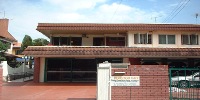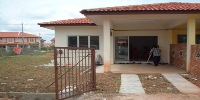More people will qualify for welfare aid under the Government’s Social Safety Net programme.
DURING an economic downturn, everyone feels the pinch, more so the poor or those living below the poverty line income.
According to the Economic Planning Unit, 16.5% of the Malaysian population lived in poverty in 1990. Twelve years later, in 2002, the rate dropped to 5.1% and last year, the poverty rate stood at 1.8%.
However, the actual number of poor people could well be higher, considering the high cost of living in urban areas and the current economic crisis.
 A group of disabled people displaying their JKSM cards which act like identity cards, proof that the cardholder is on the social aid scheme.
A group of disabled people displaying their JKSM cards which act like identity cards, proof that the cardholder is on the social aid scheme. One government mechanism that provides social support to the poor and needy is the Malaysia Social Safety Net or Jaringan Keselamatan Sosial Malaysia (JKSM) programme.
It involves various ministries and government agencies, including the Ministries of Health, Education, Housing and Local Government, Human Resources, Agriculture and Agrobased Industry, Entrepreneur and Cooperative Development, Rural and Regional Development, and, Women, Family and Community Development.
The social support given comes in various forms which include financial aid; food, fertiliser and fuel subsidies; free education, textbooks and uniforms; affordable hospital care and skills training.
Last year, a total of RM350mil was allocated to the Social Safety Net programme. This year, the amount has been raised to RM850mil.
 Senior citizens above the age of 60 who are ill, not able to work and living in poor conditions are also eligible for the Government’s social welfare aid.
Senior citizens above the age of 60 who are ill, not able to work and living in poor conditions are also eligible for the Government’s social welfare aid. An important aspect of this social support is the Federal Welfare Aid given via the Social Welfare Department under the Women, Family and Community Development Ministry.
“My ministry is only one part of this whole scheme and we are very focused on the so-called non-productive groups. They include senior citizens aged above 60 who are ill, not able to work and living in poor conditions, children aged below 18 from poor family backgrounds, and the disabled.
“We are involved in giving basic financial support to such groups,” said Minister Datuk Seri Dr Ng Yen Yen.
On Feb 25, Prime Minister Datuk Seri Abdullah Ahmad Badawi together with Dr Ng launched a revised Malaysia Social Safety Net programme and a new Social Safety Net Card (Kad JKSM).
Under this Safety Net programme, more people will qualify for welfare aid.
 The new Malaysia Social Safety Net Card or Kad Jaringan Keselamatan Sosial Malaysia (JKSM) under the Social Welfare Department of Malaysia.
The new Malaysia Social Safety Net Card or Kad Jaringan Keselamatan Sosial Malaysia (JKSM) under the Social Welfare Department of Malaysia. In previous years, welfare aid was given to the hardcore poor who, according to the Economic Planning Unit, are those with a household income of less than RM430 in Peninsular Malaysia, RM520 in Sarawak and RM540 in Sabah.
This year, the Ministry is extending aid to those with a household income of less than RM720 in Peninsular Malaysia, RM830 in Sarawak and RM960 in Sabah, or those living below the average poverty line income.
“From this year, we are extending the social safety net. This means that the number of people eligible for aid will double,” said Dr Ng.
“Last year, 150,000 people from about 50,000 families qualified for aid. This year, we expect at least 110,000 families to benefit.”
Dr Ng stressed that the poverty line income only serves as a guide or the initial entry point for eligibility of aid. Final approval will depend on investigations by welfare officers who will look into factors like the living condition of the families, the number of children and dependants, age of applicant or head of household, physical disability, and health conditions due to disease or illness.
This year, those who qualify for aid will also receive the new Kad JKSM, an electronic chip card which replaces the manila cards that people on welfare have been using since Independence.
“The card represents a new system of delivery to recognise eligible recipients. It is also (a tool) to create awareness about the welfare aid as we are determined to provide aid to those who are truly in need,” said Dr Ng.
“The card is like an identity card to prove that the cardholder is on the JKSM scheme. Later, we hope to link the card to public transportation systems and even outlets with special benefits for these groups of people.”
Each JKSM card is valid for a year and has to be reviewed annually.
“We do not want the poor to remain poor forever. We also want them to move out of poverty.”
To reach out to people in need of aid, the Social Welfare Department launched Projek Cari last October.
Under the project, 850 temporary welfare officers were hired for six months from October to go down to the ground and identify, register, investigate and speed up applications for the welfare scheme. These officers work in tandem with the existing 7,000 welfare officers in the country.
From Oct 1 to Jan 31, 70,000 new cases were identified, of which 25,000 have so far been approved. About 7,500 people did not qualify or pulled out, while the rest are still under investigation.
“Projek Cari has proven its effectiveness. The aim of the project is to reach out to as many people as possible and to create awareness. It is ongoing until March 31, after which we will review it and see if we need to extend it,” said Dr Ng.
She hopes local leaders will help identify those in need and bring them to the department’s attention.
“I want to strengthen the whole welfare delivery system in Malaysia from the context of entry point, human resource and also the JKSM card as we move towards 2020,” she said.
Aid list
THE Federal Welfare Aid scheme under the Social Welfare Department offers:
> A general monthly allowance of RM80 per person, up to a maximum of RM350 per family, subject to a household income of below RM720 for Peninsular Malaysia, RM830 for Sarawak and RM960 for Sabah.
> RM300 a month for poor senior citizens aged above 60, subject to a household income of below RM720 for Peninsular Malaysia, RM830 for Sarawak and RM960 for Sabah.
> RM100 a month per child for families earning below RM720 in Peninsular Malaysia, RM830 in Sarawak and RM960 in Sabah. This aid is subject to a maximum of RM450 per family.
> RM300 supplementary work allowance a month for a disabled person who is working and earning below RM1,200 a month.
> RM300 a month for a non-working caregiver who looks after a debilitated/bedridden person at home. This is provided the family income is less than RM3,000 a month.
> From January this year, RM150 a month will also be given to a disabled person who is unemployed despite efforts to find a job.
To apply for welfare aid and the JKSM card, go to your nearest Social Welfare office or call the Ministry’s Talian Nur hotline at 15999.
Sources: The Star












